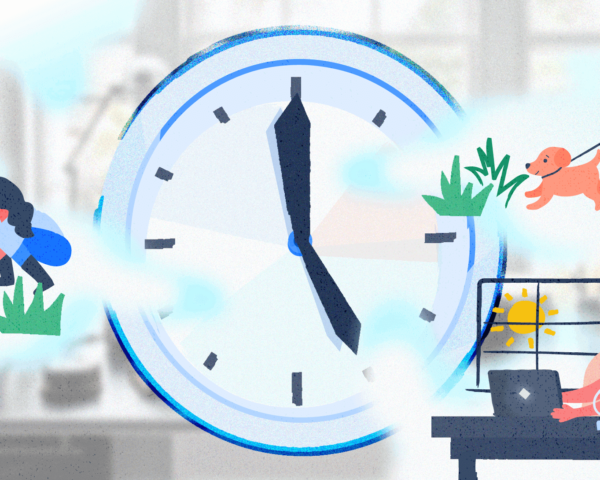Skip the screens: 3 ways old-school practices can help you work better
Maybe the Next Big Thing has been there all along…
5-second summary
- In our constant search for ways to keep our workload under control, we sometimes end up jumping from one Next Big Thing to another – but new tech and novel hacks often make us less present and less satisfied.
- Incorporating low-tech practices into our work routines can help us think outside the box, bring our work off the screen and into our physical space, and even improve our work-life balance.
- Our Atlassian LinkedIn audience weighed in with their favorite low-tech work rituals.
We’re always on the lookout for a new habit or clever hack to optimize our ever-evolving workflows. And there’s no shortage of tips, tricks, apps, and other silver-bullet solutions to that universal conundrum: how do I get my stuff done and stay sane?
On any given day, we’re bombarded with in-your-face promises of the Next Big Thing: finally, the definitive answer to our cognitive overload. So we buy the device, download the app, copy the exact morning routine of the billionaire. And a lot of times, these solutions do what they say they’ll do: we become more available and more “productive” (whatever that means), but also less present – and perhaps less satisfied with our work, and our lives.
So let’s get past the noise and throw back to some decidedly low-tech methods you can incorporate (or re-incorporate) into your work routine to help you think differently and more creatively, ground yourself in your surroundings, and even improve your work-life balance.
We asked our readers on LinkedIn to tell us what non-digital (or, in some cases, less-digital) techniques they use, and why. You might be surprised, and inspired, by the appeal of going back to the fundamentals.
3 ways low-tech practices can help you work better
1. Think in a different way
Here’s a crazy idea: use a pen.
Popular writers like J.K. Rowling, Stephen King, and Ocean Vuong (they’ve sold just a few books between the three of them) are known for using old-school techniques, including writing out drafts longhand.
Writing pen-to-paper is slower, more deliberate, and more intentional. Plus, writing something down on paper improves recall. “I’m more likely to remember it if I write it down,” says Jesse F. on LinkedIn. “If I use a computer to take notes, I’ll literally save it and never look at it again.” On a similar note, Matt Cerny says, “You’re able to commit more to memory when you use pen and paper. You can get more volume with a computer, but by writing…you [remember] the more important aspects of what you’re listening to.”
Another way to harness that more thoughtful, low-key way of moving through your day: turns out, choosing a phone call over Zoom can help you concentrate, not just on the person you’re talking with, but on your surroundings in general. By filtering out certain sensory inputs – the ding of a notification, your own face on the screen – you’re better able to put your attention where it needs to be.
Andrea Westbrook says, “I feel like I can concentrate more because I’m not worried about providing visual listening cues. I can look elsewhere, take notes and really give my attention to the other person on the call.”
2. Bring your work into your physical space
As Anatolii Landyshev put it, “Nothing beats mapping out your ideas on paper.” There’s something about seeing your inner thoughts written out, in your own handwriting, that makes it a bit more tangible. And Sarah Pollard says, “I find it better to draw my thoughts – artistic unreadable scribbles over slide decks any day.”
In the same vein of achieving that more intentional, more visceral connection to ideas, “whiteboard brainstorming… helps articulate thoughts and visualize every time,” according to Priya S. This goes triple when you’re brainstorming as a team. Swarming on an idea and laying it out for everyone to see – creating that visual context and manifesting connections with the swipe of a dry-erase marker – is like manually piecing together the collective ideas of the group.
Same goes for brainstorming on a good old-fashioned Post-It note. Often, in the beginning stages of the ideation process, the best way to get your ideas flowing is via that satisfying rapid-fire peeling-and-scribbling ritual performed on sheet after colorful sheet. Slap ‘em up on the wall, arrange and rearrange, repeat. Physically manipulating your ideas in this way adds a whole new dimension to the brainstorming process.
Plus, you can put them anywhere. Instead of being relegated to a virtual desktop or app, Post-Its can exist as a friendly reminder wherever you need them – the fridge, the bathroom mirror, the front door.
3. Gain better work-life balance
We’ve touted the importance of shutdown rituals, especially since remote work became so common. In essence, they’re a way of disconnecting from the systems and artifacts of work – and of course, this is often synonymous with “step away from the tech.”

Rituals help. They make it easier to get into the flow of work; they help us transition between different tasks throughout the day; and evening rituals help us wind down and disconnect, erecting a mental boundary between “work” and “home.”
Dave Brown engages in a ritual we like to call “analog commuting.” He says, “I work from home and I still ‘commute,’ in the morning going for a walk (and a coffee) then doing the same at the end of the work day (swapping coffee for beer, obviously).”
So, maybe you start your day with a cup of coffee and a quick scroll through the headlines. But when it’s time to take a break, do you have a ritual for getting up and stretching? Or walking the dog? In our hybrid-work world, we need them.
The trusty voice-only phone call is perfect for both. There are quite a few reasons a phone call – ear to ear, voice to voice – is effective, especially contrasted with our Zoom-reliant ways of working. Put simply, there are fewer distractions. No looking at your own face, no checking your inbox, no responding to Slack messages. On the phone, you’re really listening. And the phone gives you freedom.
New ritual: take your next meeting on the phone. Go outside, walk and talk on the phone while you’re having a 1:1 with your manager. Atlassian CRO Cameron Deatsch has been recommending a phone call for building virtual relationships for a long time. “You don’t have to do everything on Zoom,” he says. “I feel that a normal phone call, where I put on my headset and go for a walk while I’m talking with someone can almost seem more personal. The different format allows me to have a different level of conversation.”
Find what works for you
Allow yourself to experiment. Find out what works for you. Try new things, and rediscover the old. Don’t just hum the jingle of the shiny new object.
And write someone a letter. By hand. You’ll thank me later.













































